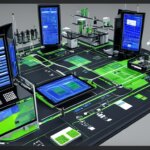Table of Contents
AV technology, short for Audiovisual technology, refers to the tools, equipment, and systems that combine audio and visual elements to create immersive and interactive experiences. It encompasses a wide range of technologies used in various fields such as entertainment, education, communication, and business.
AV technology relies on a combination of audio and visual equipment, including speakers, microphones, cameras, projectors, displays, and control systems. These components work together to capture, process, and deliver audio and visual content. AV technology also integrates multimedia elements such as images, videos, graphics, and animations to create engaging and dynamic presentations or experiences.
It offers solutions for different applications and industries, including digital signage, interactive displays, smart classrooms, home theatres, and conference room setups. AV technology involves the integration of different components and systems, and it requires careful setup, configuration, and troubleshooting to ensure optimal performance.
By understanding the basics of AV technology, individuals can make informed decisions, communicate effectively with AV professionals, and fully appreciate the potential of AV technology in various aspects of their life.
The Basics of AV Equipment
AV equipment forms the backbone of audiovisual technology, facilitating the capture, processing, and delivery of audio and visual content. To create immersive experiences, AV technology relies on a combination of audio and visual components.
Audio Systems
Audio systems encompass a range of equipment designed to ensure optimal audio reproduction. This includes:
- Speakers: Responsible for projecting sound and delivering high-quality audio.
- Amplifiers: Boost the audio signal strength to enhance volume and clarity.
- Mixers: Allow for control and adjustment of audio levels and inputs.
- Audio processors: Shape and manipulate the sound to achieve desired effects.
Video Systems
Video systems capture and display visual content. Key components include:
- Cameras: Capture live footage or pre-recorded video content.
- Projectors: Display video or images on a large screen or surface.
- Displays: Show visual content in real-time, such as monitors or screens.
Display Technologies
To ensure high-quality visual representation, AV technology employs various display technologies:
- LCD (Liquid Crystal Display): Provides sharp and vibrant images.
- LED (Light Emitting Diode): Offers enhanced brightness and energy efficiency.
- OLED (Organic Light Emitting Diode): Produces deeper blacks and wider viewing angles.
- Projection Systems: Enable large-scale visual projection for presentations or entertainment purposes.
Multimedia Integration
Multimedia integration is a crucial aspect of AV technology. It involves seamlessly combining different types of media, such as images, videos, graphics, and animations, to create dynamic and engaging presentations or experiences.
An example of multimedia integration is the blending of audio, video, and graphics to bring virtual reality (VR) experiences to life.
Proper integration and connectivity of AV equipment are essential for seamless signal flow and optimal performance.
AV equipment finds applications in various sectors, including:
- Home Theaters
- Conference Rooms
- Classrooms
- Entertainment Venues
Understanding the different types of AV equipment empowers individuals to select the right solutions that address their specific needs and preferences.
| Application | Example |
|---|---|
| Home Theaters | Immersive audio systems, large displays, and high-quality projectors |
| Conference Rooms | Professional audio systems, video conferencing equipment, and interactive displays |
| Classrooms | Microphones, projectors, interactive whiteboards, and audio amplification systems |
| Entertainment Venues | Concert-grade sound systems, large LED video walls, and specialized lighting equipment |
The Future of AV Technology
AV technology is continuously evolving, and there are several advancements that shape its future. With the rise of video conferencing, remote communication and collaboration have become essential. Regardless of their physical location, people can now connect and interact in real-time, thanks to video conferencing tools. This technology has revolutionized the way businesses operate and individuals communicate, enabling seamless collaboration and fostering global connections.
Another significant development in AV technology is the emergence of online events. Nowadays, individuals can enjoy concerts, theater performances, and conferences from the comfort of their homes. Online events provide immersive experiences through high-quality audio and visual components. They offer convenience, accessibility, and the ability to engage with diverse content from various industries.
The integration of virtual reality (VR) and augmented reality (AR) is transforming the AV industry. VR technology immerses users in a virtual world by using headgear and earpieces, creating lifelike and interactive experiences. On the other hand, AR overlays digital content onto the real world, enhancing the user’s perception and interaction with their surroundings.
Both VR and AR have applications in gaming, entertainment, education, and other industries. From virtual tours to interactive learning experiences, AV technology enables new possibilities for engaging and dynamic content. As AV technology continues to advance, companies are focused on enhancing user experiences, improving collaboration tools, and expanding the capabilities of AV systems to create even more immersive and engaging audiovisual experiences in various fields.
FAQ
What is AV technology?
AV technology, short for audiovisual technology, refers to the tools, equipment, and systems that combine audio and visual elements to create immersive and interactive experiences in various fields such as entertainment, education, communication, and business.
What components are included in AV technology?
AV technology relies on a combination of audio and visual equipment, including speakers, microphones, cameras, projectors, displays, and control systems. These components work together to capture, process, and deliver audio and visual content, incorporating multimedia elements like images, videos, graphics, and animations.
What are the applications of AV technology?
AV technology offers solutions for different applications and industries, including digital signage, interactive displays, smart classrooms, home theaters, and conference room setups.
How does AV equipment contribute to audiovisual technology?
AV equipment forms the backbone of audiovisual technology, allowing for the capture, processing, and delivery of audio and visual content. It includes audio systems comprised of speakers, amplifiers, mixers, and audio processors, as well as video systems that encompass cameras, projectors, and displays. Display technologies like LCD, LED, OLED, and projection systems provide high-quality visual representation.
What is the importance of proper integration and connectivity in AV technology?
Proper integration and connectivity of AV equipment are crucial for seamless signal flow and optimal performance. It ensures that audio and visual content is delivered without interruptions or technical issues.
What are the different types of AV equipment?
AV equipment includes speakers, amplifiers, mixers, audio processors, cameras, projectors, displays, and various multimedia elements. Understanding the different types of AV equipment allows individuals to select the right solutions for their specific needs and preferences, whether it’s for home theaters, conference rooms, classrooms, or entertainment venues.
What advancements are shaping the future of AV technology?
The future of AV technology is being shaped by advancements such as video conferencing for remote communication and collaboration, online events for virtual attendance, and technologies like virtual reality (VR) and augmented reality (AR) for immersive and interactive experiences. Companies are also focusing on enhancing user experiences, improving collaboration tools, and expanding the capabilities of AV systems.












